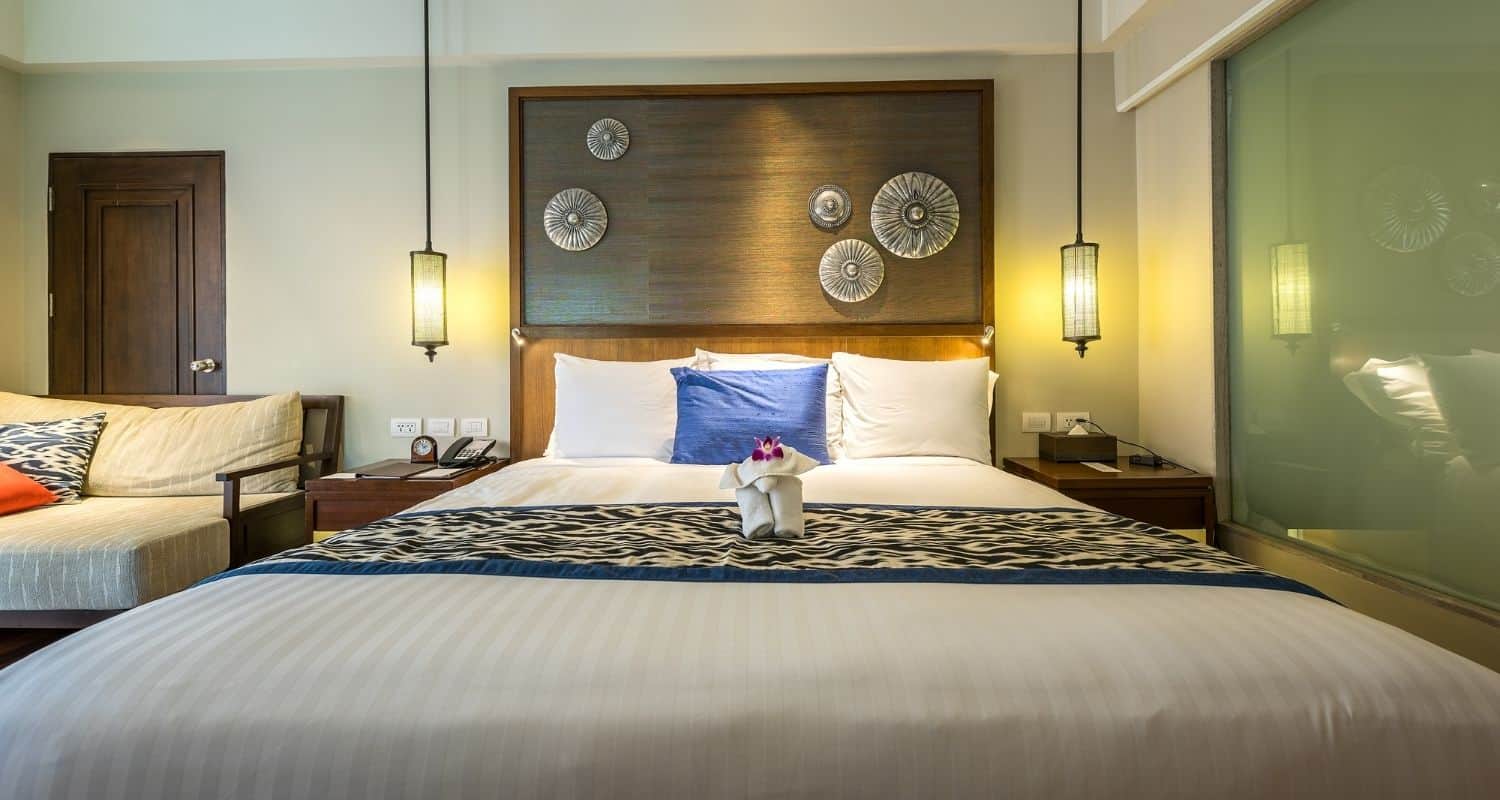How Many People Can Stay in a Hotel Room? A Comprehensive Guide
Booking a hotel room can be a daunting task, especially when you’re unsure about the occupancy limits. Whether you’re planning a family vacation, a business trip, or a weekend getaway with friends, understanding how many people can legally and comfortably stay in a hotel room is crucial.
If you’re short on time, here’s a quick answer to your question: The number of people allowed to stay in a hotel room typically ranges from two to four, depending on the room type and the hotel’s policies.
In this comprehensive guide, we’ll delve into the factors that determine hotel room occupancy, explore different room types and their capacities, discuss legal and safety considerations, and provide tips for maximizing comfort and ensuring a pleasant stay for all guests.
Room Types and Occupancy Limits
When booking a hotel room, it’s essential to understand the different room types and their occupancy limits. After all, you wouldn’t want to end up cramped in a tiny space or paying extra for a larger room than you need.
Here’s a breakdown of common room types and how many people they can accommodate.
Standard Rooms
Standard rooms, also known as double or queen rooms, are the most common and budget-friendly option. These rooms typically have one or two queen or double beds, with space for two to four adults. According to Statista, the average hotel room occupancy rate in the United States was around 60% in 2021, indicating that many standard rooms accommodate fewer than their maximum capacity.
Suites and Family Rooms
For larger groups or families, suites and family rooms offer more space and amenities. Suites usually consist of a separate living area and bedroom, accommodating four to six people. Family rooms, on the other hand, often have two queen beds and a sofa bed, comfortably sleeping up to six guests.
These rooms are perfect for families or groups traveling together, providing extra room to move around and relax.
Accessible Rooms
Accessible rooms are designed to meet the needs of guests with disabilities or mobility issues. These rooms typically have wider doorways, roll-in showers, and other accessible features. While the occupancy limits may vary, most accessible rooms can accommodate two to four guests, depending on the room size and layout.
It’s always a good idea to check with the hotel directly for specific accessibility requirements and availability.
Adjoining Rooms
For larger groups or families seeking more privacy, adjoining rooms can be a great solution. These rooms are connected by a door, allowing guests to move freely between the rooms while maintaining separate sleeping areas.
Adjoining rooms can accommodate anywhere from four to ten people, depending on the number of rooms booked and their individual occupancy limits. This option is popular for multi-generational families, wedding parties, or groups traveling together.
Remember, occupancy limits are not just a matter of comfort but also safety. Hotels have strict fire codes and regulations that dictate the maximum number of guests allowed in each room type. When in doubt, it’s always best to consult with the hotel staff to ensure a comfortable and compliant stay for everyone in your party.
😊
So, whether you’re planning a romantic getaway, a family vacation, or a group trip, understanding room types and occupancy limits can help you make an informed decision and have a truly enjoyable hotel experience.
After all, there’s nothing better than waking up well-rested and ready to explore your destination! 🎉
Legal and Safety Considerations
When it comes to determining how many people can stay in a hotel room, legal and safety considerations play a crucial role. Hotel operators must adhere to strict regulations and guidelines to ensure the well-being of their guests and minimize potential liabilities.
Here are some key factors to consider:
Fire Safety Regulations
Fire safety is a top priority in the hospitality industry, and hotels must comply with stringent fire codes and regulations. These regulations dictate the maximum occupancy limits for guest rooms based on factors such as room size, number of exits, and the presence of fire detection and suppression systems.
Exceeding the occupancy limits can compromise the safety of guests and staff, potentially leading to fines or even legal action. According to the National Fire Protection Association (NFPA), the leading authority on fire safety codes, guest rooms in hotels must have a minimum of 200 square feet of floor area for the first two occupants, with an additional 50 square feet for each additional occupant.
Building Codes and Occupancy Standards
In addition to fire safety regulations, hotels must comply with local building codes and occupancy standards. These codes specify the maximum number of people allowed in a room based on factors such as room size, ventilation, and the availability of emergency exits.
Violating these codes can result in hefty fines or even the closure of the hotel. According to a study by the American Hotel & Lodging Association (AHLA), approximately 15% of hotels in the United States have faced penalties or legal action due to occupancy violations. 🚨
Hotel Liability and Insurance
Overcrowding in hotel rooms can also have significant legal and financial implications for hotel operators. If an accident or injury occurs due to overcrowding, the hotel may be held liable for negligence or breach of duty of care.
This can lead to costly lawsuits and damage to the hotel’s reputation. Additionally, insurance companies may refuse to cover claims or increase premiums if hotels are found to be in violation of occupancy regulations.
According to a survey by Insurance Journal, over 20% of hotel liability claims in the United States are related to overcrowding or occupancy violations. 😮
To mitigate these risks, hotels must carefully monitor and enforce occupancy limits. Many hotels have implemented strict policies and procedures, such as requiring guests to disclose the number of occupants during booking and conducting random room checks.
Ultimately, adhering to legal and safety considerations is not only a matter of compliance but also a matter of ensuring the safety and well-being of guests, staff, and the hotel’s long-term success.
Maximizing Comfort and Space
When it comes to hotel stays, maximizing comfort and space is crucial for an enjoyable experience. Whether you’re traveling solo, with a partner, or as a family, the right room configuration and amenities can make all the difference.
In this section, we’ll explore various bed configurations, additional bedding options, and room amenities to help you make the most of your hotel stay.
Bed Configurations
The number of people a hotel room can accommodate largely depends on the bed configuration. Here are some common options:
- Single/Twin Room: Typically features one twin/single bed, ideal for solo travelers or couples who prefer separate sleeping spaces.
- Double Room: Includes one double/full-size bed, suitable for couples or close friends.
- Queen Room: Offers one queen-size bed, providing ample space for two adults or a small family with a young child.
- King Room: Features one king-size bed, perfect for couples seeking extra room or those who prefer a larger sleeping area.
- Double-Double Room: Contains two double/full-size beds, accommodating up to four people comfortably.
It’s worth noting that hotel room sizes can vary, so it’s always a good idea to check with the property for specific dimensions and bed sizes to ensure a comfortable stay.
Additional Bedding Options
If you’re traveling with a larger group or have specific sleeping preferences, many hotels offer additional bedding options to accommodate more guests. These may include:
- Rollaway beds: Portable beds that can be added to a room for an additional fee.
- Sofa beds: Couches that convert into a bed, often found in suites or larger rooms.
- Cots or cribs: Provided for families traveling with infants or young children.
It’s essential to inquire about these options in advance, as availability and fees may vary across hotels and room types.
Room Amenities and Facilities
Beyond bed configurations, several room amenities and facilities can enhance your comfort and make the space feel more spacious. These may include:
- Spacious bathrooms with separate tub and shower areas
- Ample closet space and luggage racks for storage
- Seating areas with chairs or sofas for relaxation
- Complimentary Wi-Fi and entertainment options like smart TVs or streaming services
- In-room coffee makers, mini-fridges, and other conveniences
Additionally, many hotels offer on-site amenities like pools, fitness centers, and restaurants, which can provide a sense of space and freedom during your stay. According to a survey by Statista, 81% of travelers consider free Wi-Fi as the most important hotel amenity, followed by free parking (67%) and a complimentary breakfast (60%).
By considering these factors, you can make an informed decision and choose the hotel room configuration and amenities that best suit your needs, ensuring a comfortable and enjoyable stay. Don’t be afraid to ask the hotel staff for recommendations or clarifications – they’re there to help you maximize your experience!
Special Considerations for Groups and Families
When traveling with a group or family, finding suitable accommodations can be a challenge. Hotel rooms are typically designed for a couple or a small family, but larger groups may require more space and flexibility.
Fortunately, many hotels offer options to cater to the needs of groups and families, ensuring a comfortable and enjoyable stay for everyone.
Booking Multiple Rooms
One of the most straightforward solutions for groups or large families is to book multiple rooms. This allows for more privacy and personal space, as well as the ability to spread out and not feel cramped.
However, booking multiple rooms can be more expensive, especially during peak travel seasons or in popular destinations. To save money, consider looking for hotels that offer discounts for booking multiple rooms or group rates.
Additionally, websites like Hotels.com and Expedia often provide package deals for booking multiple rooms together.
Connecting Rooms and Suites
Many hotels offer connecting rooms or suites, which can be a great option for groups or families traveling together. Connecting rooms provide separate sleeping areas while still allowing easy access between the rooms.
Suites, on the other hand, typically feature a larger living area and separate bedrooms, providing more space and privacy. While these options can be more expensive than standard rooms, they offer a more comfortable and convenient experience for larger groups.
According to a survey by TripAdvisor, 68% of families prefer to book suites or connecting rooms when traveling with children.
Discounts and Packages
To make group or family travel more affordable, many hotels offer discounts and packages specifically designed for larger parties. These can include discounted room rates, complimentary breakfast, or even free stays for children under a certain age.
Be sure to inquire about any available discounts or packages when booking your stay. Additionally, consider joining hotel loyalty programs, as members often receive exclusive discounts and perks.
Another option to consider is vacation rentals or home-sharing services like Airbnb and VRBO. These platforms offer entire homes or apartments that can accommodate larger groups, often at a lower cost than multiple hotel rooms.
Plus, you’ll have access to amenities like a full kitchen and living spaces, making it feel more like a home away from home. 😊
Traveling with a group or family can be an amazing experience, but it does require some extra planning and consideration. By exploring options like booking multiple rooms, connecting rooms or suites, and taking advantage of discounts and packages, you can ensure a comfortable and enjoyable stay for everyone in your party.
Don’t be afraid to ask the hotel staff for recommendations or assistance in finding the perfect accommodations for your group. With a little preparation, your group or family trip can be a memorable and stress-free adventure! 🎉
Tips for Booking and Communicating with Hotels
Clarifying Occupancy Policies
When planning a hotel stay, it’s crucial to clarify the occupancy policies upfront. Different hotels have varying rules regarding the maximum number of guests allowed per room. According to a report by Hotel Management, the standard occupancy limit for a standard room is typically two adults and two children under 12 years old.
However, some hotels may allow up to four adults per room, while others may have stricter policies.
To avoid any confusion or additional charges, it’s best to communicate your group size and specific needs during the booking process. Don’t hesitate to ask the hotel directly about their occupancy policies and any additional fees that may apply for extra guests or roll-away beds.
By being transparent and proactive, you can ensure a smooth and hassle-free stay for everyone in your party. 😊
Requesting Specific Room Types
Not all hotel rooms are created equal, and different room types cater to different needs. If you’re traveling with a larger group or have specific preferences, it’s essential to request the appropriate room type during the booking process. Here are some common room types to consider:
- Standard rooms: Typically accommodate 2-4 guests
- Family rooms or suites: Offer more space and separate living areas, perfect for families or groups
- Adjoining or connecting rooms: Ideal for larger groups or families who want privacy while staying together
- Accessible rooms: Designed for guests with mobility challenges or disabilities
By clearly communicating your needs and preferences, hotels can better accommodate your group and ensure a comfortable stay for everyone. Don’t be afraid to ask about room configurations, amenities, and any additional charges that may apply for specific room types. 👍
Negotiating Rates and Upgrades
While hotels have standard rates, savvy travelers know that there’s often room for negotiation, especially during low seasons or when booking well in advance. Here are some tips for negotiating better rates and potential upgrades:
- Book directly with the hotel: Many hotels offer better rates and perks when booking directly through their website or by calling their reservations line.
- Join loyalty programs: Hotels often offer discounts and upgrades to members of their loyalty programs.
- Ask for discounts: Don’t be afraid to inquire about any available discounts, such as AAA, military, or corporate rates.
- Negotiate upgrades: If the hotel has availability, you may be able to negotiate a room upgrade for a nominal fee or even complimentary. 🎉
By being polite, flexible, and willing to negotiate, you may be able to secure better rates or even complimentary upgrades, making your hotel stay even more enjoyable and cost-effective. Remember, it never hurts to ask! 😉
Conclusion
Determining how many people can stay in a hotel room is a crucial aspect of planning a successful and comfortable trip. By understanding room types, occupancy limits, legal and safety considerations, and strategies for maximizing space and comfort, you can make informed decisions and ensure a pleasant stay for all guests.
Remember, open communication with the hotel staff and clear understanding of their policies are key to avoiding any misunderstandings or potential issues. Whether you’re traveling solo, with a partner, or with a larger group, this comprehensive guide will equip you with the knowledge and tips you need to book the perfect accommodation for your needs.





